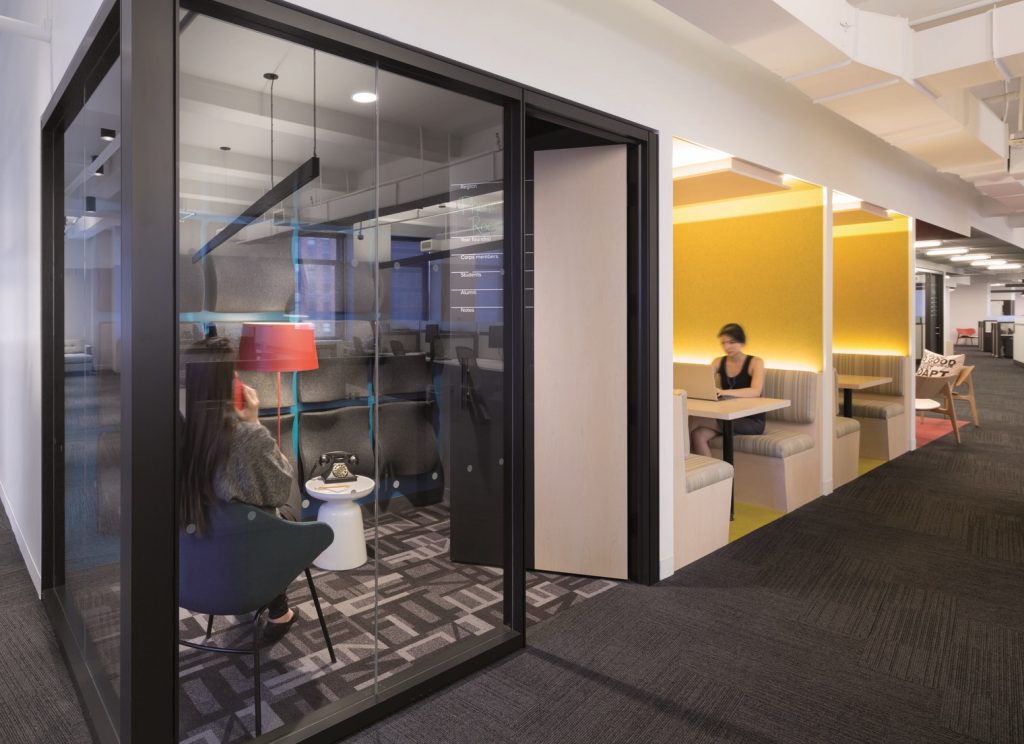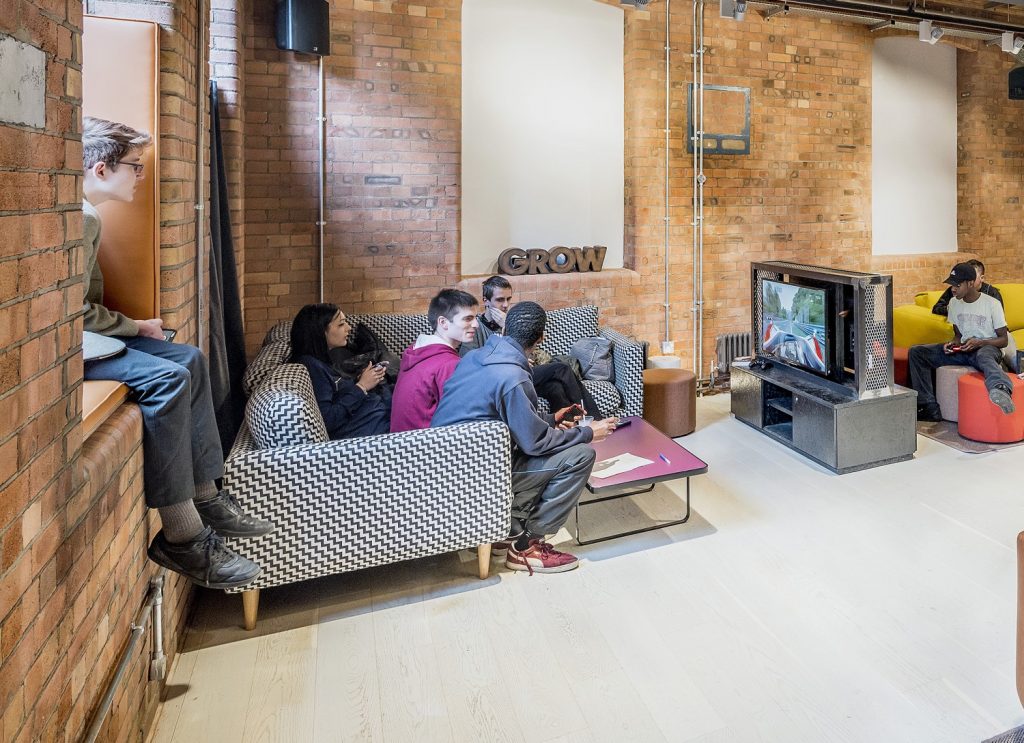
Dairy Farmers of America, Kansas City, Kansas. © 2017 Michael Robinson. Corporate Lounge Environment.
by Kay Sargent, ASID, IIDA, CID, LEED® AP, MCR.w, WELL AP and Betsy Nurse, ASID, LEED® AP — Recently numerous articles in popular media have called into question the effectiveness of open plan workspaces. Be it “Google got it wrong. The open-office trend destroying the workplace,” or “The origins of the open office hellscape,” or “The go-to fix for open offices is a nightmare too.” These articles miss the true issue of many of these spaces – what happens when a design concept is misunderstood or more likely, misused. The operative word in most of these pieces is “open-plan office.” We have moved far beyond that and just because an office has a more open environment it does not mean it is “open-plan.” As designers and workplace strategists we understand the nuances of various planning models and the drivers that help determine what the right solutions should be.
The open-plan concept was introduced in the 1990s but heavily adopted during the Global Financial Crisis in 2008. Touted as creating collaborative environments, it often was more about reducing space and improving efficiencies, but often at the cost of effectiveness. Not only has the nature of work evolved dramatically but so too has our understanding of how workspaces can foster engagement, satisfaction and productivity. Since that time more advanced planning models have emerged. But unfortunately they often get lumped into the same category as open plan space. Today work environments have evolved a generation beyond open plan spaces to Activity-Based Workplaces (ABW) and Neighborhood-based Choice Environments (NCE). Companies focused on speed to innovation are embracing Agile Environments and we are also seeing the evolving of Maker Environments, Mobile Occupants (MEMO) space and Immersive Environments. These new strategies challenge the traditional approach to office planning, and for good reason.
WorkHOW
Gone are the days where work was a place you had to go, and workers did repetitive tasks throughout the day. Work today is dynamic. The workforce is diverse and what we do varies from day-to-day, often hour-to-hour. So the workplace has to be designed to be in tune with, and supportive of, how, when and where we work today. Yet many companies still operate their workplace with a one-size-fits-all approach that fails to reflect the diverse ways people work today.
Considering that people are the greatest asset and expenditure for companies, designing to foster their success is imperative. 80% of a company’s cost goes to people cost, while only 10% goes to real estate and the other 10% goes to IT. People are the chief currency of business today. Yet a recent Gallup,[1] study notes that 68 percent of employees are disengaged at work. Hence if we negatively impact the ability of people to be successful because we are too focused on reducing real estate cost, any savings we might gain could be dwarfed by the cost an ineffective workplace has on employee productivity and satisfaction. We have to design with people top of mind.
So the big questions are what are the options and how does a company know which type of workspace solution is right for its employees? Understanding the true needs of an organization is what drives to the right solutions. Now more and more organizations are looking to create curated experiences that truly serve as an asset to the business and the people within them.
Planning Concepts
Guide to prevalent planning models of the day.
 Open-Plan
Open-Plan
Definition: Creation of low or no panel spaces with limited enclosed areas. Work points are assigned and there are some support space options available.
Characteristics:
- Efficient, collaborative
- Limited or no offices or private space
- Lowered panels and greater access to natural light
- Assigned Seats
- Fewer support areas required because limited movement happens when people are assigned a work point
- All work points must be? equal since they are assigned with no choice
Considerations:
- Is everyone doing similar and repetitive tasks?
- Are limited levels of focus and interaction required?
- Are staff tethered to their work points throughout the day?
Activity-Based Workplace (ABW)
Definition: Designed around the tasks people do, not assigned spots for individuals. Unassigned seating encourages movements and people can select the right setting for the task at hand.
ABW supports a shift from “me space” to “we space.” Instead of giving everyone a desk, which could go unused during a typical day, ABW offers a hybrid environment that gives employees choices about how, when and where they work. Employees in ABW environments are encouraged to work wherever they are most productive for the task at hand. All have access to a wide variety of settings including unassigned private rooms, focus booths, and formal and informal collaborative areas.
Characteristics:
- Different settings are designed to support specific tasks
- The focus is on effectiveness, and providing variety and choice
- Unassigned, free-address seating
- Balance of concentrative zones and interactive areas.
- Permission signaling created by providing a variety of heights and work point locations workers can select from to signal availability
Considerations:
- Are there are variety of tasks that are being performed or is everyone doing similar and repetitive tasks?
- Are different levels of focus and interaction required?
- Does your IT enable mobility?
- Is wellbeing a focus or concern?
Neighborhood-Based Choice Environments (NCE)
Definition: Activity based space subdivided in neighborhoods that enable people to nest, huddle and feel a sense of belonging while still having access to diverse work settings.
When people have no home base, culture can erode as choices abound and teams and individuals feel less grounded and connected. Hence, the next evolution of workplace goes beyond ABW to provide Neighborhood-based Choice Environments (NCE). People connect more effectively in smaller group settings that allow them to feel a sense of place, to nest, huddle and belong while still having access to a variety of work settings in a neighborhood setting. Each neighborhood serves as a home base that integrates elements of these functions. Community space is created to meet the needs of each group while tying the groups to the larger organization. Ideal neighborhoods use the “Power of 6 to 48,” which organizes work points in groups of six, clusters of 24 and neighborhoods of 48. These spaces provide belonging, reinforce culture and empower teams with choices.
Characteristics:
- Team-based, sense of belonging
- Wide variety of task-based settings for highly mobile teams
- Assigned for groups, unassigned for individuals
- Shift from a “me” identity to a “we”
- Incorporate a variety of options for each setting type to enable permission signaling:
- Standing height team tables with no screens that encourage groups to gather and interact
- Seated team tables with height-adjustable desks
- Fixed seated and fixed standing teams
- Individual seated work points along the periphery for more solo work
- Provide different levels of focus spaces:
- Solo desks in the open area that reduce visual distractions
- Enclosed rooms for brief private conversations or focused work
- Quiet zones for deep concentration for extended periods
- Customization options per team allow for the creation of a team identity and personalization
Considerations:
- Is the work force internally and externally mobile?
- Is the ability for teams to personalize their neighborhoods to reinforce team identity, sense of pride and purpose and a sense of belonging important?
- Is enabling permission signaling important?
- Is it important to provide different levels of spaces, including interactive, social, concentrative space and refresh areas?
Agile Environments
Definition: Space that aligns with the ‘Agile Methodology’ approach and designed to support cross-functional project-based teams working in close proximity so they can collaborate, track and deliver the project.
Agile spaces, that’s Agile with a capital “A,” are designed to support the Agile Methodology. Agile organizations strive to be dynamic and responsive, hence their space should be as well. Those that embrace the “Work Out Loud” or “better together” philosophy. In these environments, organizations are designed around a network of team areas focused on rapid ideation, prototyping, speed to innovation, and fast decision cycles. These spaces cultivate a scrum or maker mentality. The notion is that people that work closely together in a centralized location begin to think alike, build stronger bonds and trust, and can ideate and innovate faster.
Characteristics:
- Focus on innovation via collaborate, tracking and delivering the project
- Groups working in close proximity
- Team-based scrums
- Low to no mobility during scrum time as the focus is to be together.
Considerations:
- Is your focus on innovation, ideation and problem solving?
- Do your teams function in an Agile manner?
- Will restricting movement and cross-pollination support the way your teams function?
- Do you want to empower teams to “own” spaces, and are you willing to allow them to reconfigure it as needed and get “messy?”
Maker Environments for Mobile Occupants (MEMO)
Definition: Think “scrum” spaces bleeding out across the whole office to create a scrappy, entrepreneurial space with a variety of settings.
True MEMO spaces put people in control of their experiences. These spaces are often focused on speed to innovation and cultivate a scrum or maker mentality throughout the entire environment instead of confining these activities to teams and special spaces. At their most raw, MEMO environments reflect the “garage-ification” of space. Often these spaces blend attributes from siloed sectors to create new opportunities, or Space Fusion. Be it combining hospitality into corporate spaces to create “corpitality,” or mixing elements from the gig economy and coworking to create innovation bullpens or “collaboratory spaces.” Interweaving signature elements of various planning concepts and sectors together is creating sophisticated, cultured approaches to experiential environments and driving to tomorrow’s innovations.
Characteristics:
- “Garage-ification,” fungible, agile and adaptable space
- Environments can transition at a moment’s notice and evolve to respond to a team’s work cycle.
- Incorporate both stationary and movable elements to offer flexibility to meet changing needs.
- Provide auxiliary spaces to encourage informal discourse between colleagues, continuation of a discussion or brainstorming meetings.
Considerations:
- Is your focus on ideation, creativity and innovation?
- Do you empower staff to function in a manner that suits their personal work style and mobility profile?
Immersive Environments
Definition: Immersive spaces are tailored to create curated, human-centric spaces that reflect the organizational DNA of company and the people within it.
Immersive environments support the unique attributes of an organization, regardless of the trends. Immersive environments can blend elements from a variety of planning concepts into a flexible framework.
Characteristics:
- Function-driven, human-centric experiential space
- Tailored, curated solutions
Considerations:
- Is your focus on fitting the model or breaking it?
- Are you ‘cutting edge’, a ‘fast follower’ or a ‘wait and see’ culture?
- Do you empower staff to function in a manner that suits their personal work style and mobility profile?
- Are you encouraging and supportive in creating tailored, curated spaces that reflect the organization’s mission, purpose and unique attributes?
- Is it a goal to empower people through place?
Conclusion
As the workplace continues to evolve from “open plan” to “immersive” spaces, we need to continually assess it to determine what is working and what isn’t. We need to embrace the reality that different companies need different solutions and be willing to acknowledge the side effects of each model to ensure we are applying the right planning concept for our clients. If we focus on finding the right solutions, not just on what is trending, we can help workplace get its mojo back and create spaces that are powerful assets for businesses and the people within them.
 Kay Sargent, ASID, IIDA, CID, LEED® AP, MCR.w, WELL AP, Senior Principal | Director of WorkPlace, HOK
Kay Sargent, ASID, IIDA, CID, LEED® AP, MCR.w, WELL AP, Senior Principal | Director of WorkPlace, HOK
In her 33 years of experience Kay’s work has taken her to multiple continents where she has worked with companies on their global real estate strategies and designed workplaces of the future. Kay leads HOK’s WorkPlace team where she oversees a team working with clients to deliver workplace solutions around the world. Kay serves on the International Federation of Interior Designers /Architects and on the CoreNet Global Board. She has also served on the International Boards of IIDA, ASID, and NCQLP. Kay is one of the founders of the IFMA Workplace Evoluntionaries, WE community, and a Founding member of the DC Chapter of Upward. You may contact Kay at Kay.sargent@hok.com.
 Betsy Nurse, ASID, LEED® AP, Principal | Director of Interiors – Atlanta, HOK
Betsy Nurse, ASID, LEED® AP, Principal | Director of Interiors – Atlanta, HOK
With over 20 years’ experience, Betsy is passionate about orchestrating strategy and design solutions to create dynamic, highly-functional and user-centric interior environments. As a Principal and Director of Interior Design for HOK’s Atlanta practice, her professional experience in higher education, healthcare and corporate workplace inspires new ways to integrate and balance well-being, technology and flexibility for people and businesses. Betsy is President-Elect of CoreNet Global’s Atlanta Chapter, President Emeritus of The Atlanta Contemporary Arts Center and lectures nationally on the evolution of the workplace and addressing the challenges of the future. You may contact Betsy at Betsy.Nurse@hok.com.
[1] http://www.gallup.com/reports/199961/state-american-workplace-report-2017.aspx

